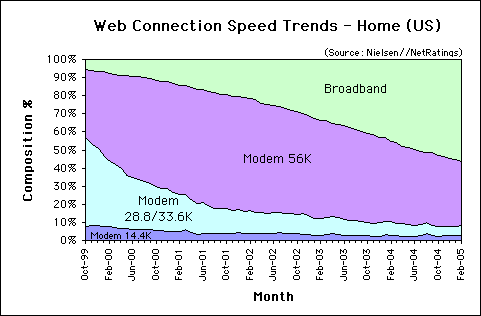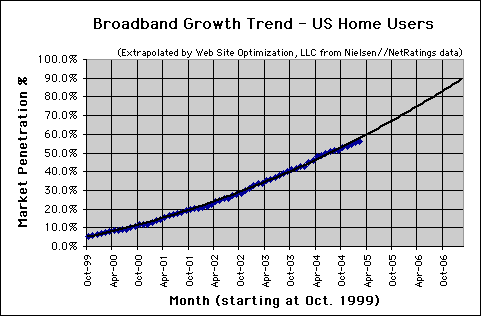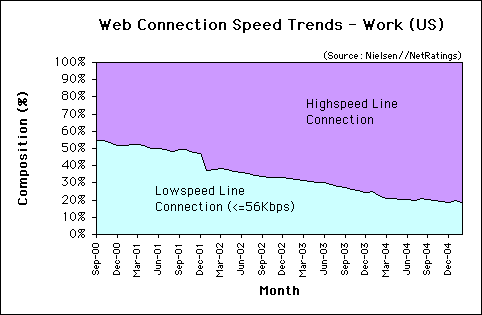Worldwide, broadband penetration has reached 62% among Internet users, according to the “Face of the Web” survey by Ipsos-Insight. The annual survey found that while broadband penetration grew by 24% last year, narrowband connections still dominate many rural areas in Russia, India, Mexico, Brazil, France and the U.K. In February, broadband penetration among active Internet users in the U.S. grew by 0.55 percentage points to 56.29%. Narrowband penetration in US homes fell to 43.71% in February 2005.
The charts below, derived from Nielsen//NetRatings data, show trends in connection speeds to the Internet for United States users.*
Home Connectivity in the US
Most active Internet users connect from home with broadband connections. Among narrowband users, 35.68% use 56Kbps modems, 5.04% use 28/33.3Kbps, and 2.99% use 14.4Kbps modems. In total, 43.71% of home users in the US connect to the Internet at 56Kbps or less (see Figure 1).
Web Connection Speed Trends – Home Users (US)
Figure 1: Web Connection Speed Trends – Home Users (US)
Source: Nielsen//NetRatings
Broadband Growth in the US
Broadband penetration in the US grew by 0.55 points to 56.29% in February, up from 55.47% in January. This increase is below the average increase in broadband of 1.04 points per month over the previous twelve months. At the current growth rate, broadband share in the US should exceed 70% by January of 2006 (see Figure 2). As it approaches 60 to 65%, broadband penetration growth appears to be tapering off in the US, in a pattern similar to Canada and Korea.
Broadband Connection Speed Trend – Home Users (US)
Figure 2: Broadband Connection Speed Trend – Home Users (US)
Extrapolated from Nielsen//NetRatings data
Work Connectivity
Most workers in the US enjoy high-speed connections to the Internet. Most use a high-speed line such as a T1 connection, and share bandwidth between computers connected to an Ethernet network. The speed of each connection decreases as more employees hook up to the LAN. As of February of 2005, of those connected to the Internet, 81.56% of US users at work enjoy a high-speed connection, up 1.37 percentage points from 80.19% in January. At work, 18.44% connect at 56Kbps or less (see Figure 3).
Web Connection Speed Trends – Work Users (US)
Figure 3: Web Connection Speed Trends – Work Users (US)
Source: Nielsen//NetRatings
It’s a Broadband World After All
Worldwide, broadband penetration among Internet users grew by 24% in 2004. 62% use broadband as their primary Internet connection, according to “The Face of the Web” survey by Ipsos-Insight. The fastest broadband adoption rates were found in France, Urban Brazil and the U.K., growing by 59%, 50%, and 45% respectively. However, the report found the world is still divided into haves and have nots. Dial-up regions include urban Russia, India, Mexico, and Brazil and the European regions of France and the U.K. Nearly 6 in 10 U.S. users access the Internet through a high-speed connection.
Further Reading
- The Majority Of Global Internet Users Using A High-Speed Connection
- Two-thirds of global Internet users access the Internet through broadband from any device or location, according to “The Face of the Web” study from Ipsos-Insight. March. 2, 2005
- Nielsen//NetRatings
- Provides the US broadband data (percentage of active Internet users) for the Bandwidth Report.
*Note that Nielsen//NetRatings reports the percentage of active Internet users that use broadband from home, not broadband households. NetRatings uses a panel of 40,000 to 50,000 people with software meters installed on their computers. These meters detect connection speeds. Each month they do an enumeration study to call a number of people to calibrate the panel by adjusting weightings to match the population at large.
The Bandwidth Report is featured monthly on URLwire – news of useful and unique web content since 1994.



